-

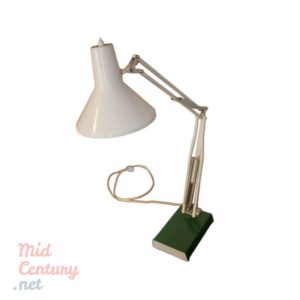
Vintage architect table lamp by HCF
Lighting, Table LampsBeautiful white and green Architect table lamp made by HCF in Denmark, in the 1970s. The lamp has all its original elements and is in great vintage condition. The lamp is marked on the bottom arm.120 €120 € -

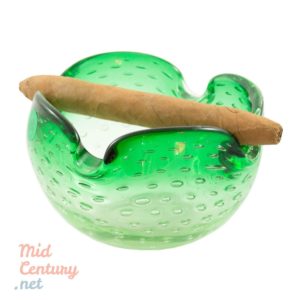
Controlled bubbles (bullicante) Murano ashtray
Glass & Ceramics, Home AccessoriesBeautiful controlled bubbles (bullicante) Murano ashtray made of glass. Hand blown, this piece displays a nice chromatic effect and goes from dark green (to the rim) to clear white (at the bottom). The quality and tradition that characterize Murano’s finest glass furnaces have always been worthy of the highest appreciation. This prestige is due mostly to the glass masters’ hard work and dedication, which are the very core of Murano’s most famous trade. Glassmaking has been passed on from one generation to the next one, with constant innovations and timeless originality. The loyalty and respect with which this trade is treated is possibly the key to Murano’s success. Glass masters all over the island have always worked with endless vitality, and this creative vein is evident in every glass artwork that comes out of any furnace, with improved techniques and bewildering effects. The “bullicante” effect is amongst the most famous glass making techniques and it is seen quite often around the island of Murano. If you’ve had the fortune of strolling along the streets of Venice, you would have noticed beautiful glass pieces with small air bubbles trapped in the inside, possibly stopping to wonder how that seemingly impossible effect is achieved. This peculiar effect is obtained by placing a piece of molten glass inside a metallic mold with spikes, very much resembling a pineapple’s texture. These spikes cause small holes on the surface creating a pattern all around the glass piece. After it’s been left to cool down for a few moments, the whole piece is submerged in molten glass again. This second layer completely covers the first one. However, thanks to the thick consistency of glass, the holes previously impressed on the first layer are not covered, thus causing air to be trapped between both layers of glass. This process can be repeated several times, creating a pattern as complicated as the glass master wishes. This technique gives not only a sense of depth to the whole object, but also an incomparable decorative effect, famous for its originality. Source: glassofvenice.com40 €40 € -
Sold out
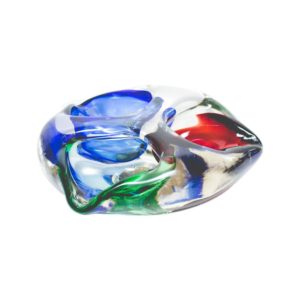

Tricolor Murano ashtray (or dish) in blue, red and green
Sold ItemsTricolor Murano ashtray (or dish) in blue, red and green. This piece is remarkable in its fluid shapes, the zoomorphic look (seen from the top, it resembles the image of a cat's head), the fine quality of the glass, and the dialogue between the three differently colored compartments. Hand blown, this piece is kept in very good vintage condition. The quality and tradition that characterize Murano’s finest glass furnaces have always been worthy of the highest appreciation. This prestige is due mostly to the glass masters’ hard work and dedication, which are the very core of Murano’s most famous trade. Glassmaking has been passed on from one generation to the next one, with constant innovations and timeless originality. The loyalty and respect with which this trade is treated is possibly the key to Murano’s success. Glass masters all over the island have always worked with endless vitality, and this creative vein is evident in every glass artwork that comes out of any furnace, with improved techniques and bewildering effects. Source: glassofvenice.com45 €45 € -
Sold out
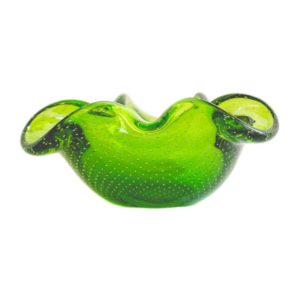

Green bullicante Murano ashtray
Sold ItemsBeautiful controlled bubbles (bullicante) ashtray made of glass in Murano, Italy, in the 1960s. Hand blown, this pice features the shape of a flower in an amazing shade of translucent emerald green. The quality and tradition that characterize Murano’s finest glass furnaces have always been worthy of the highest appreciation. This prestige is due mostly to the glass masters’ hard work and dedication, which are the very core of Murano’s most famous trade. Glassmaking has been passed on from one generation to the next one, with constant innovations and timeless originality. The loyalty and respect with which this trade is treated is possibly the key to Murano’s success. Glass masters all over the island have always worked with endless vitality, and this creative vein is evident in every glass artwork that comes out of any furnace, with improved techniques and bewildering effects. The “bullicante” effect is amongst the most famous glass making techniques and it is seen quite often around the island of Murano. If you’ve had the fortune of strolling along the streets of Venice, you would have noticed beautiful glass pieces with small air bubbles trapped in the inside, possibly stopping to wonder how that seemingly impossible effect is achieved. This peculiar effect is obtained by placing a piece of molten glass inside a metallic mold with spikes, very much resembling a pineapple’s texture. These spikes cause small holes on the surface creating a pattern all around the glass piece. After it’s been left to cool down for a few moments, the whole piece is submerged in molten glass again. This second layer completely covers the first one. However, thanks to the thick consistency of glass, the holes previously impressed on the first layer are not covered, thus causing air to be trapped between both layers of glass. This process can be repeated several times, creating a pattern as complicated as the glass master wishes. This technique gives not only a sense of depth to the whole object, but also an incomparable decorative effect, famous for its originality. Source: glassofvenice.com55 €55 € -
Sold out


Pair of FD109 Teak Lounge Chair by Ole Wanscher for France & Søn, 1960s
Sold ItemsBeautiful pair of teak lounge chairs FD-109 model by Ole Wanscher, designed in the 1950s and made in the 1960s by France and Son. The pieces are in good vintage condition, with normal signs of use due to age and with a lovely patina of time. Due to the influence of light, the colors may be distorted. Please see the detailed images.1.350 €1.350 € -
Sold out


FD109 Teak Lounge Chair by Ole Wanscher for France & Søn, Denmark, 1956
Sold ItemsElegant lounge chair designed by Ole Wanscher for France & Søn in Denmark, 1960s. This vintage model FD-109 lounge chair maintains the manufacturer’s mark and features a sturdy teak wood frame with a slated open back and angled legs for an organic aesthetic. The minimalist lounge chair shows Danish modern exceptional design principles and making this chair the ideal fit for a modern or contemporary interior. The piece is in good vintage condition, with normal signs of use due to age and with a lovely patina of time. Due to the influence of light, the colors may be distorted. Please see the detailed images.715 €715 € -
Sold out


Rosewood set with 3-seater sofa & 2-seater sofa by Lennart Bender for Stjernmobler
Sold ItemsImpressive Scandinavian Modern solid varnished rosewood set with a 3-seater sofa and 2-seater sofa designed by Lennart Bender for Stjernmobler in Herrljunga, Sweden, in the 1960s. The sofas are accompanied by three lovely pillows. Condition Report: The frame is structurally sound, incredibly strong and sturdy, rosewood is in good vintage condition. The upholstery is in original condition so show uniform signs of wear due to age and use, with some rips on the back of long pillows (please see the photos). Although we avoid altering the original elements, we still recommend reupholstery in this case. Please note that we can reupholster the sofas according to your preference, so please contact us if you wish this. If you need additional details or pictures, do not hesitate to contact us. These sofas are, in themselves, rare items. All the less together as a set. Elegant, refined, proving the excellence of the Scandinavian design, the two pieces fit both the sumptuous interiors, as central pieces, and the minimalist ones, as design accents.3.000 €3.000 € -
Sold out
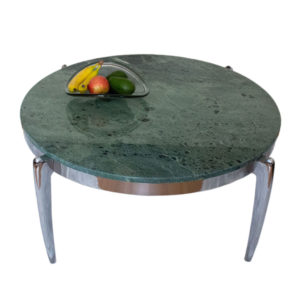

Spectacular coffee table made of marble and stainless steel
Sold ItemsSpectacular coffee table made in Germany, in the 1970s. The top of the table - made of Green Alps marble - has a quite impressive diameter (98 cm) and is in perfect shape. It's exquisite color (green with black swirls and veins) is placed in a remarkable dialogue with the coldness and the sobriety of the structure, made of well-polished stainless steel. The legs of the table, resembling the fins of a space-rocket, are consistent with Atomic/Space Age design shapes and lines This is special, stylish, well preserved piece of furniture that can accommodate any contemporary interior, be it minimalist, modern or industrial. The Space Age is a time period encompassing the activities related to the Space Race, space exploration, space technology, and the cultural developments influenced by these events. The Space Age is generally considered to have begun with Sputnik (1957). During the 1950s, architecture, furniture, interior design, cars, and gadget design took on a curiously spaceflight-inspired aesthetic.400 €400 € -
Sold out
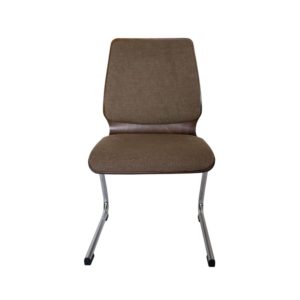

Set of 4 Wiesner-Hager chairs made in Austria in the 1970s
Sold ItemsVery well preserved set of 4 Wiesner Hager chairs made in Austria in the 1970s. Plywood with cherry wood veneer and a tubular steel cantileverd structure. They have the original fabric upholstery. The chairs have an ergonomic shape, featuring organic, curved lines, but an overall industrial design look, being that kind of furniture items that are as much about function as style. Wiesner-Hager was founded by Josef Wiesner as a carpentry business in 1849. In the year 1921 Rudolf Wiesner and Sebastian Hager took over their father’s business, which was at that time purely a carpentry and construction company. With the restructuring of part of the construction business into a furniture manufacture the two lay the cornerstone for a second branch of the business. Now, due to major changes in the working world and the enormous upheavals in the office and properties branch, the furniture offering has been expanded since the noughties to include the services of office consulting and interior design: Concept orientation has become a key success factor. With an export quota of 50% Wiesner-Hager is currently one of the most renowned companies in the furniture branch in Europe.320 €320 € -
Sold out


Danish Model 125 Lounge Chairs with Ottoman by Tove & Edvard Kindt-Larsen for France & Son, 1958
Sold ItemsElegant Model 125 armchairs with ottoman designed by Tove & Edward Kindt-Larsen (husband and wife design team) for France & Son in 1958 and manufactured in Denmark. The armchairs are made of teak and features fixed cushions in a soft green textile. he design is distinguished by its bowed armrests, clean joinery, and the delicate, V-shaped supports cradling the base of the backrest. Retains the original brass France & Son label on the underside of the frame. One of the armchairs has a restored armrest (see photos) but the items are in an overall good vintage condition.1.800 €1.800 € -
Sold out


Two rare British P802 (PK737 model) armchairs from Parker Knoll, 1960s
Sold ItemsTwo rare Mid-Century Modern P802 (PK737 model) armchairs produced by Parker Knoll for the French market in the 1960s. The armchairs were newly reupholstered and are in a very good vintage condition (defects visible in the pictures). The model is iconic for British Modern design and is highly inspired from the Danish Modern lines of that period. Each armchair has its original Parker Knoll stamp.600 €600 € -
Sold out


Windsor 478 armchair with ottoman by Lucian Ercolani for Ercol, 1950s, UK
Sold ItemsBeautiful and very comfortable Windsor 478 armchair with ottoman. This armchair was designed by Lucian Ercolani for Ercol and was manufactured during the 1950s in the United Kingdom. The frame of the armchair and ottoman are made of solid ash-wood. The quiet dialogue between the green of the upholstery and the honey-color of the wood is very elegant and the item is in a very good vintage shape. It preserves both original labels (the one on the armchair is just a partial, but the one on the ottoman is intact).525 €525 € -
Sold out


Signed Daum Nancy crystal ashtray from the 1960s
Sold ItemsSpectacular crystal ashtray signed by Daum Nancy and made in France, in the 1960s. The translucent emerald color and the flower-shaped line give this piece a refined, elegant and discreet look. It’s signed on the bottom "Daun Nancy" – Cross of Lorraine – "France", in the typical manner of this famous manufacturer. Also retains the label of the first crystal shop that sold it: "Cristallerie Moser-Millot Paris 30 Bd. Des Italiens". Is in a very good condition, with minimal age related signs. Daum Nancy rose to prominence during the Art Nouveau and Art Deco period, and captured the imagination of collectors all over the world. Let us take a quick look at the interesting events that shaped the company. Jean Daum was a notary from Bitche who had lent some money to the proprietors of a glass factory in Nancy, the capital town of the French region of Lorraine. The glassworks was then named "Verrerie Sainte Catherine". In 1878, Daum took over the factory when its erstwhile owners were unable to pay off their debt and renamed it "Verrerie de Nancy". The factory initially produced glassware such as drinking glasses and pitchers and then ventured into artistic glass manufacturing in 1891. After Daum’s death in 1885, his son Auguste Daum took over the control of the company in the year 1890. The Daum brothers exhibited their "Handsome Tavern Glass" at the Paris International Exhibition in 1889. This event was of utmost significance because it marked the birth of the French Art Nouveau movement. Daum received his first "Grand Prix" in 1900 because by then his factory had established its name as a producer of high quality glass. By 1903, Daum had started making vitrified vases. These vases are singularly responsible for the kind of fame the company acquired in the early 1900s. In 1906 Daum began the manufacture of pâte-de-verre, a glass-making technique first used over five thousand years ago in the early world. In order to understand the collector’s interest in Daum Nancy objects, one must realize that this company has shaped itself up to become a producer of glass art objects and not simple glassworks. It pioneered and revolutionized old techniques by working with colour powders, acids, enamel and fluorine hydrogen. From the early 1900s emphasis was placed upon ornamental motifs in naturalistic forms. When Galle died in 1904, the Daum brothers became the leaders in the field of decorative glass and their dominance lasted for one productive, golden decade. Source: artnewsnviews.com120 €120 € -
Sold out


Set of two large Clan floor lamps by Harvey Guzzini for Meblo
Sold ItemsSet of two large Clan floor lamps by Harvey Guzzini for Meblo. The great modern form emits a beautiful, warm green glow. Soft light is diffused through the graduated tint of the acrylic globe shade. The white acrylic dome top rests in an chromed metal ring frame and lifts to reveal a translucent white interior and a single medium base socket. The lamp rests in a cylindrical fiberglass base which allows directional positioning of the light source. If you are interested in buying just one of the two lamps, the price is 500 euros. Please contact us on hello@mid-century.net for details. Harvey Guzzini is often mistakenly thought to be the name of a lighting designer active in the 1960s and 1970s. But in fact the label belongs to a lighting manufacturing company, which was founded by six Guzzini brothers - Raimondo, Giovanni, Virgilio, Giuseppe, Adolfo and Giannunzio - who were inspired by the 1950 film Harvey starring James Stewart. Compounding the historical record even further, it seems that the Guzzini company rebranded many times in the 20th century, going by, at various points, Harvey Creazioni, Harvey Guzzini, Guzzini, iGuzzini, and Illuminazione Guzzini. Harvey Creazioni was originally founded in 1959 in Recanti (on the east central coast of Italy) by Raimondo, focusing on the production of copper-plated decorative objects. Four years later, in June 1963, the six brothers joined together and established Harvey Creazioni di Guzzini, expanding production to include pendant lighting, sconces, and lamps, floor lamps. The brothers employed architect-designer Luigi Massoni—who was introduced to the Guzzini brothers by leading plastic importer Maurizio Adreani—as head of design, branding, public relations, and advertizing. Famous Harvey Guzzini designs include Massoni and Luciano Buttura's Mushroom Table Lamp (1965), as well as the in-house designed Arc Floor Lamp (1968), Faro Table Lamp (1970), and Toledo Table Lamp (1973). Studio 6G, an interning design team, developed the collectible Clan Lamp (1968); and designers Ermanno Lampa and Sergio Brazzoli were responsible for the Nastro Series (1970), Orione Pendant (1970), Sirio Table Lamp (1970), Alba Floor Lamp (1973), Albanella Table Lamp (1973), and Alf Series (1976).800 €800 € -
Sold out


Mid-Century German olive armchairs, 1950s, set of two
Sold ItemsBeautiful pair of Mid-Century armchairs made in Germany in the 1950s. The items have a robust yet elegant look and features the sober lines of the Central European Modernism. The armchairs have new upholster in the same color as the original one. Also the decorative pins were applied manually. The items are in very good vintage condition and they can fit (and warm) any interior.500 €500 € -
Sold out


Murano sommerso vase from the 1950s
Sold ItemsBeautiful Murano sommerso vase in green and purple. The piece is made in the 1950s and is kept in very good condition, showing no visible deterioration. It has the original label. When thinking of Murano glass, it is highly unlikely that we think of sand, yet this rare material is at the base of all glass production. Glass is firstly a mix of siliceous sand, soda, lime and potassium, which is put to melt inside an oven at a temperature of around 1.500 Celsius. After it has become flexible enough, it is removed with a pipe that will be used to blow the glass out while the glassmaker shapes and models it. The forms and colors given to each piece depend on the tools and chemicals used during its production. The techniques are also important.. One of the most common techniques is “Sommerso”, which in Italian literally means “submerged”. This technique is used to create several layers of glass (usually with different contrasting colors) inside a single object, giving the illusion of “immersed” colors that lay on top of each other without mixing. This is done by uniting different layers of glass through heat and repeatedly immersing them in pots of molten colored glass. This technique is quite recognizable: it is characterized by an outer layer of colorless glass and thick layers of colored glass inside it, as if a big drop of color had been captured inside the transparent glass. When one first sees these objects, it seems almost impossible to conceive such beautiful colors being locked so perfectly inside what would seem solid glass, and then undoubtedly one begins to wonder how ever did they manage to achieve such a complex game of shapes and colors right in the middle of a clear glass object. Source: glassofvenice.com75 €75 € -
Sold out
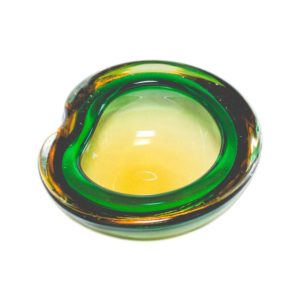

Green and brown bowl made in Murano, in the 1950s
Sold ItemsBeautiful geode bowl made in Murano, Italy, in the 1950s. Nicely colored, in shades of brown and green, this is a hand blown piece kept in very good vintage condition. Murano glass Geode bowls earn the name "geodes" due to their resemblance to geode rocks - rocks or stones that have been sliced neatly in two. The geode bowls therefore have a perfectly flat, wide rim. Murano glass geodes consist of two or more layers of cased glass. They were made my several Italian glass manufacturers from the Venetian island of Murano, and as such it is virtually impossible to identify the maker of an unmarked bowl. Popular geode shapes include circular, square, triangular, figure eight, and kidney shaped among others. Source: 20thcenturyglass.com50 €50 € -
Sold out


Imposing emerald fruit bowl made in Murano in the 1970s
Sold ItemsImposing emerald fruit bowl made in Murano in the 1970s. This tall, massive, beautifully colored piece is in very good vintage condition, showing no visible defects. During World War II the industry did not thrive, but as soon as the war was over the glass masters of Murano returned to their art and created pieces deeply rooted in interior design trends of that time with focus on minimalism, functionality, and simplicity. To support these trends Murano artists and artisans returned to techniques of the past such as filigree, murrino, and lattimo. From that point onwards Murano saw continued exploration of styles and techniques striving to find a happy medium between the technical mastery and the outline, color, and decoration. The resulting continuous innovation led to a rise in popularity and to multiple prizes at various international art exhibitions. Thanks to such prominent artists as Archimede Seguso, Ludovico and Laura De Santillana, Tobia Scarpa, Ercole Barovier, Fulvio Bianconi, Toni Zuccheri, Romano Chrivi, Giampaolo Martinuzzi, and Alfredo Barbini, Murano again became known as the glassblowing capital of the world. Murano now created the art trends as opposed to following them in the years past. Source: glassofvenice.com100 €100 € -
Sold out
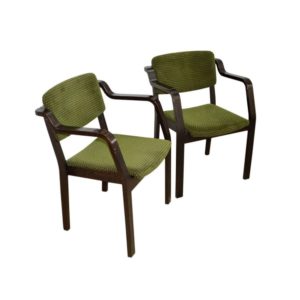
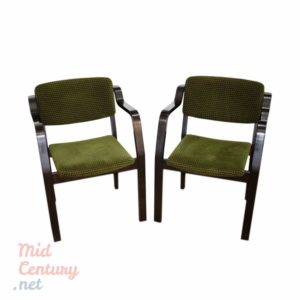
Pair of Gemla Möbler chairs made in Sweeden, in the 1980
Sold ItemsPair of Swedish Gemla Mobler chairs. The structure and the armrests - made of curved wood - give a natural, organic and pleasant shape. This is completed in a beautiful way by the wool upholstery, in a shade of green that is specific for the Mid-Century furniture. This chairs can fit any nice interior, having the ability to create a warm atmosphere in the room. The chairs are in very good shape with only few age-related traces. At Helge River in Diö, in the heart of the old forests of Småland, lies Sweden's oldest furniture factory (founded in 1861). Its inner sanctum, beech and ash are tamed into time- less furniture by skilled craftsmen who know which way the wood likes to bend. Stretching and flexing, easing and teasing, until the steaming hot wood finds its form. And the wood will not be rushed. The transformation from log into chair takes days, sometimes even weeks. The technique has been used by boat and fence builders since ancient times but was refined in the mid 1800's by Thonet into the iconic chair, worn my millions of seats in the cafés of Europe. The shape is determined by the best and the brightest of their time. Back then their names were Peter Celsing, Yngve Ekström, Sigurd Lewerentz and Carl Malmsten. Now they are Jonas Bohlin, Front, Lisa Hilland and Mats Theselius.150 €150 € -
Sold out


Danish desk chair from Labofa, 1960s
Sold ItemsA wonderful 1960s Labofa Danish rolling office chair in vivid green tweed. The chair is very easy to move because the well engineered wheels: a fun and playful chair for your office or home. The chair has some traces of use one its legs (please see photos) but is in overall good vintage condition and full working order. The seat is adjustable in height. The backrest is adjustable in both height and position.150 €150 € -
Sold out


Little green and pink table lamp
Sold ItemsBeautiful and suave Art Deco green and pink table made in Germany in the 1950s. The table lamp has a light green body, a brass tube and a pink lampshade made of plastic. It also has it's original switcher. The lamp is in full working order and in good vintage condition.80 €80 € -
Sold out


Elegant Daybed made in Germany in the 1960s
Sold ItemsElegant daybed made in Germany in the late 1960s or early 1970s. Made of wood, this sofa is extensible on its left side (see pictures). The model is typical for the period and the vivid green colour, in a nice dialogue with the dark wooden parts, is a recuring theme of the german rationalism in design. The sofa is in good vintage condition. All the defects are visible in pictures.750 €750 € -
Sold out
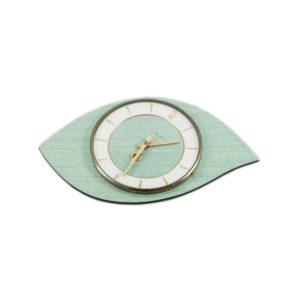
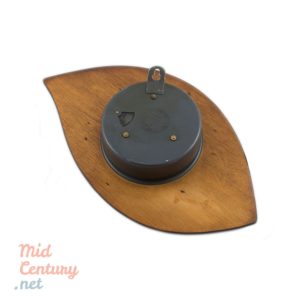
Bayard wall clock made in France
Sold ItemsBeautiful Bayard wall clock made in France in the 1950s. It features a laminated wood green case (Formica/Laminex) and an Art Deco dial. This clock can give a sophisticated touch to any room. This is a mechanical clock and has to be manually winded once a week to operate. It is in very good condition with only small age-related traces.50 €50 € -
Sold out
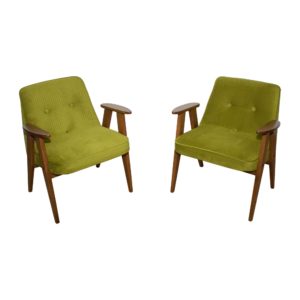
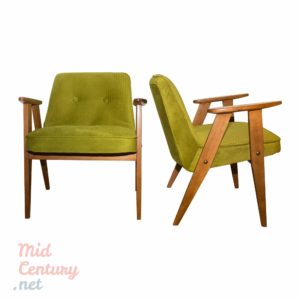
Pair of Józef Chierowski’s 366 armchairs made in Poland
Sold ItemsBeautiful pair of Józef Chierowski's 366 armchairs, made in Poland. Featuring the new Atomic Age aesthetics, this items are iconic for the Polish Modernism. The armchairs have been recently restored and are in great condition. Józef Marian Chierowski (1927 – 2007) was an eminent interior and furniture designer. He graduated from the Faculty of Interior Design at PWSSP in Wrocław, where in 1976 became the Head of the Department of Design. After 1980, he returned to the Department of Interior Design, where he led the Workshop of Furniture Design (together with Piotr Karpiński). He was strongly associated with Dolnośląska Fabryka Mebli (Lower Silesia Furniture Factory) in Świebodzice, where the prototype of the armchair 366, the symbol of the his success, was made. Józef Chierowski’s works can be admired, among other places, in the National Museum in Warsaw.500 €500 € -
Sold out

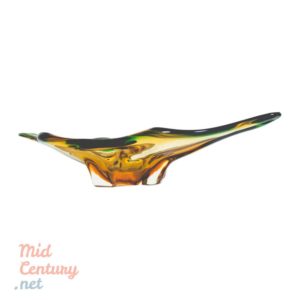
Green & brown Murano fruit bowl made in the 1950s
Sold ItemsGreen & brown Murano fruit bowl made in the 1950s. Of considerable size and, at the same time, remarked by the suppleness of its lines and silhouette, this fruit bowl (kept in very good vintage condition) can successfully be the central piece of any table. During World War II the industry did not thrive, but as soon as the war was over the glass masters of Murano returned to their art and created pieces deeply rooted in interior design trends of that time with focus on minimalism, functionality, and simplicity. To support these trends Murano artists and artisans returned to techniques of the past such as filigree, murrino, and lattimo. From that point onwards Murano saw continued exploration of styles and techniques striving to find a happy medium between the technical mastery and the outline, color, and decoration. The resulting continuous innovation led to a rise in popularity and to multiple prizes at various international art exhibitions. Thanks to such prominent artists as Archimede Seguso, Ludovico and Laura De Santillana, Tobia Scarpa, Ercole Barovier, Fulvio Bianconi, Toni Zuccheri, Romano Chrivi, Giampaolo Martinuzzi, and Alfredo Barbini, Murano again became known as the glassblowing capital of the world. Murano now created the art trends as opposed to following them in the years past. Source: glassofvenice.com110 €110 € -
Sold out

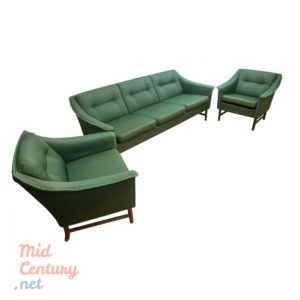
Beautiful Living Room set by Bruksbo Tegnekontor design studio
Sold ItemsBeautiful Living Room set consisting of a sofa and two armchairs designed by the famous Bruksbo Tegnekontor design studio and made at Stranda Industri a/s in the 1960s. This set is the creation of Torbjørn Afdal, the most famous of their designers. The rosewood frame, the wide armrests, the minimalist outline, all are typical for his style. Both the sofa and the armchairs have their original upholstery. [spb_products title="Items in this bundle:" asset_type="selected-products" products="21214,21201" display_type="standard" display_layout="standard" multi_masonry="no" carousel="yes" fullwidth="no" columns="2" item_count="8" order="DESC" button_enabled="no" width="1/1" el_position="first last"]1.450 €1.450 € -
Sold out

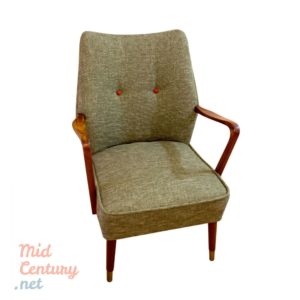
Armchair by P. I. Langlo’s Fabrikker
Sold ItemsTowering Norwegian Mid-Century armchair produced in Stranda, probably at P. I. Langlo's Fabrikker. The armchair shows Scandinavian Modern representative elements, like rosewood tapered legs and brass decorations. The backrest and armrests (in solid rosewood) have a gentle, natural line, avoiding sharp angles; this gives the piece a pleasant, organic look. The armchair was reupholstered in the zeitgeist of Lango's models and is in a very good condition.300 €300 € -
Sold out
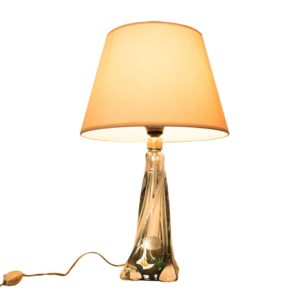
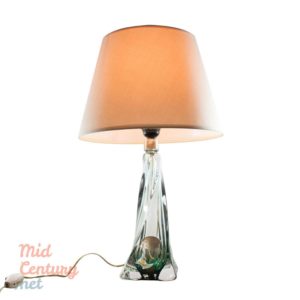
Spectacular Val St Lambert crystal lamp
Sold ItemsSpectacular table lamp signed Val Saint Lambert. This hand-made piece is made in the 1960s by the most prominent crystal manufacturer in Benelux, official supplier to H.M. the King of Belgium. Signed on the bottom, "Val St. Lambert". Still has the original label. The piece is in a very good condition.250 €250 € -
Sold out
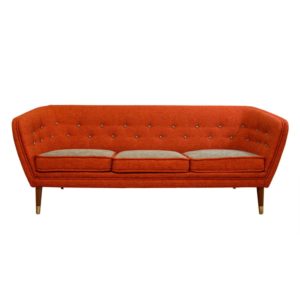

Very rare P. I. Langlo sofa
Sold ItemsSuperb and very rare three seats sofa produced by P. I. Langlo's Fabrikker, the father of the Norwegian Modern furniture, sometime between 1932 and 1940. This piece, made of rosewood, already shows some of the representative elements of the Scandinavian Modern Style: flared legs and brass shoes. The continuous line of the backrest and armrests provides an elegant and unitary outline. The pillows, with seagrass inside, are extremely comfortable. The sofa was reupholstered in the zeitgeist of Lango’s models. The pillows are green on a side and red on the other side (as shown in the pictures), so the seat of this sofa can change color depending on your taste and design needs. The sofa has the original label, specifying the factory, the type (1737) and the production number (245). Every P. I. Langlo's Fabrikker was hand-made, in several weeks. This is a highly rare piece, that despite its age (almost 80 years) is in very good condition.2.800 €2.800 € -
Sold out

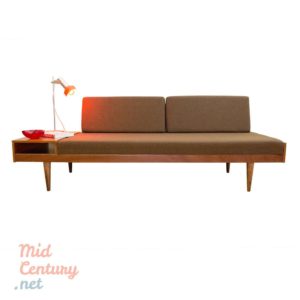
Mid-Century daybed by Swane Mobler
Sold ItemsBeautiful daybed made in Norway, at Swan Mobler, in the 1960s. The legs and structure are made of solid teak. The bed features an end table finished with teak veneer, teak is finished veneer. At the opposite end, an extension allows you to re-position the cushions. Both the mattress and pillows were the original upholstery. The bed presents only small signs of wear. This is a special piece, characterized by simplicity and minimalism. Due to its non-intrusive aspect, this daybed can be accommodated in room and can become your favorite reading place.550 €550 € -
Sold out


Leather lounge chair with ottoman
Sold ItemsLounge armchair with ottoman manufactured in Sweden in the late 1980s or early 1990s. The structure of the chair is made of laminated wood. A fine leather, dyed green, was used for upholstery.400 €400 €
Green
Home » Green
- You cannot add "Danish Model 125 Lounge Chairs with Ottoman by Tove & Edvard Kindt-Larsen for France & Son, 1958" to the cart because the product is out of stock.
Showing all 31 results
